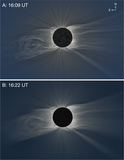The Double-bubble Coronal Mass Ejection of the 2020 December 14 Total Solar Eclipse
Abstract
Total solar eclipses (TSEs) continue to provide an invaluable platform for exploring the magnetic topology of the solar corona and for studying dynamic events such as coronal mass ejections (CMEs)with a higher spatial resolution over a larger spatially continuous extent than is possible to achieve with any other method at present. In this Letter, we present observations of the full extent of a double-bubble CME structure from the solar surface out to over 5 solar radii, as captured during the 2020 December 14 TSE. Its evolution through the corona was recorded from two observing sites separated by 13 minutes in their times of totality. The eclipse observations are complemented by a plethora of space-based observations including: Extreme Ultraviolet observations of the solar disk and low corona from SDO/AIA and STEREO-A/EUVI, white-light coronagraph observations from SOHO/LASCO-C2, radio from STEREO-A/WAVES and WIND/WAVES, and X-ray from GOES-16. We also characterize the magnetic field with a potential field source surface model. This CME event itself is of particular interest, as it demonstrates interactions between a prominence channel and an active region that led to the double-bubble structure. Despite the plethora of space-based observations, only the eclipse data are able to provide the proper context to connect these observations and yield a detailed study of this unique CME.
- Publication:
-
The Astrophysical Journal
- Pub Date:
- June 2021
- DOI:
- 10.3847/2041-8213/ac05ca
- arXiv:
- arXiv:2106.04027
- Bibcode:
- 2021ApJ...914L..39B
- Keywords:
-
- Solar corona;
- Solar eclipses;
- Solar coronal mass ejections;
- Solar prominences;
- Solar active regions;
- Solar coronal streamers;
- 1483;
- 1489;
- 310;
- 1519;
- 1974;
- 1486;
- Astrophysics - Solar and Stellar Astrophysics
- E-Print:
- 12 pages, 5 figures, accepted for publication in ApJ Letters
